Abstract
Background
With the pandemic dissemination of COVID‐19, attitude and sentiment surrounding facial rejuvenation have evolved rapidly.
Aims
The purpose of this study was to understanding the impact of pandemic on the attitude of people toward facial skin rejuvenation.
Methods
Twitter data related to facial rejuvenation were collected from January 1, 2020, to April 30, 2020. Sentiment analysis, frequency analysis, and word cloud were performed to analyze the data. Statistical analysis included two‐tailed t tests and chi‐square tests.
Results
In the post‐declaration, the number of tweets about facial rejuvenation increased significantly, and the search volume in Google Trends decreased. Negative public emotions increased, but positive emotions still dominate. The words frequency of “discounts” and “purchase” decreased. The dominant words in word cloud were “Botox,” “facelift,” “hyaluronic,” and “skin.”
Conclusion
The public has a positive attitude toward facial rejuvenation during the pandemic. In particular, minimally invasive procedures dominate the mainstream, such as “Botox,” “Hyaluronic acid,” and “PRP.” The practitioners could understand the change of the public interest in facial rejuvenation in time and decide what to focus on.
Keywords: Covid‐19, facial rejuvenation, sentiment analysis, Twitter, word cloud
1. INTRODUCTION
In late December 2019, the world has witnessed an outbreak of a disease that would become known as coronavirus disease 2019 (COVID‐19). 1 On March 11, it was officially declared a world pandemic by WHO. 2 According to the Johns Hopkins Coronavirus Resource Center as of June 8, 2020, this viral infection has spread to six continents with 7 049 649 confirmed cases and 409 821 deaths worldwide. 3 Most countries have implemented restrictive large‐scale quarantine measures to control the epidemic, resulting in severe global socio‐economic chaos. 4
This pandemic has had a significant impact on most industries, including cosmetic surgery institutions. Facial rejuvenation procedures can be roughly divided into facelift surgery and less invasive procedures, 5 such as botox injections, 6 hyaluronic acid fillers, 7 or microdermabrasion. 8 Facial rejuvenation is one of the most important businesses of cosmetic surgery institutions. It is well worth studying the impact of the epidemic on demand for facial rejuvenation.
Twitter is a free social media website, with 166 million registered daily users. 9 Moreover, Twitter has been successfully used in academic research on textual information, including medical‐related research. 10 , 11 , 12 , 13 As an essential source of unfiltered public opinion on data, using its data may provide insight into the general attitude about facial rejuvenation during the COVID‐19 epidemic in the social realm.
However, to date, there has been no research using a series of tweets to study the impact of pandemic transmission of COVID‐19 on facial skin rejuvenation. This study was undertaken to identify and investigates tweets associated with facial rejuvenation procedures during the COVID‐19 epidemic. The present study analyzes a set of tweets to understand the influence of the pandemic on public attitudes toward facial rejuvenation.
2. MATERIALS AND METHODS
2.1. Data source
This study uses a sample of 79 422 tweets about facial rejuvenation from January 1, 2020 to April 30, 2020. The period is of the essence because during this time, the deadliest outbreak was prevalent throughout the globe, and attitude and sentiment surrounding facial rejuvenation have changed. The search volume of “Covid‐19” in Google Trends ushered in a big explosion from March 5 to March 17, and then remained stable at a high level. Based on the declaration of WHO and Google Trends, the period was divided into the pre‐declaration (2020/01/01‐2020/03/04), outbreak period (2020/03/05‐2020/03/17) and the post‐declaration (2020/03/18‐2020/04/30).
Based on statistics from the American Society of Plastic Surgeons on cosmetic and reconstructive plastic surgery procedures in 2018, the search terms were selected because of the most popular cosmetic procedures. 14 The search function of Twitter was used to generate a list of tweets with the terms: botulinum toxin type A, botox, hyaluronic acid, platelet‐rich plasma (PRP), laser skin resurfacing, microdermabrasion, facelift, and rhytidectomy. Exclusion criteria included the following: (a) tweets not in English; (b) private accounts requiring approval for access to content; (c) tweets with content unrelated to search terms. When we searched, the tweets with links were filtered, because these tweets need to rely on external links to explain. Some tweets about "platelet‐rich plasma" were deleted because they were mainly related to hair treatment and not just facial skin rejuvenation. While we focused on tweets related to facial rejuvenation, it so happened that since the timeframe of our research coincided with the COVID‐19 outbreak in the globe, most of the tweets naturally associated with it.
2.2. Data analysis
Google Trends has emerged as the most used search engine worldwide. 15 The trend analysis of search terms was performed using it to gain insight into public interest in facial rejuvenation‐related issues. Due to the low volume of specific search terms in Google Trends, such as “Botulinum Toxin Type A,” this study chose “Botox,” “Hyaluronic acid,” “PRP,” “Laser skin resurfacing,” “Microdermabrasion,” and “Facelift” as search terms. As a comparison, we also searched “COVID‐19” to visually observe changes in the volume of these search terms during this period.
This article enriches this literature by employing the natural language toolkit (NLTK) for sentiment analysis and frequency analysis to explore changes and trends among collected Twitter data to understand the opinions of people toward facial rejuvenation procedures during the COVID‐19 epidemic. In sentiment analysis, each sentence is analyzed according to whether it conveys positive, negative, or neutral sentiment to determine the score, which is a standard value between −1 and 1. Tweets with a final score higher than 0 are identified as positive emotional tweets, less than 0 are defined as negative emotional tweets, and equal to 0 are defined as neutral emotional tweets. 16 Word Cloud is a novel way to illustrate the public's perspectives. The larger the word's size in the cloud, the more frequently it appears in the tweets.
Statistical analysis included two‐tailed t tests and chi‐square tests by using SPSS (Statistical Product and Service Solutions) 22, which is published by IBM, New York, USA. To test significant differences between pre‐declaration and post‐declaration, we calculated the t tests (P < .05) for tweets per day and sentiment analysis. It included the overall and each of the search terms. The distribution ratio of search terms and sentiment in the two groups was examined, with chi‐square tests being used to identify significant differences.
3. RESULTS
3.1. Google trends
There was almost no search volume of “COVID‐19” in the pre‐declaration (2020/01/01‐2020/03/04), the search volume increased exponentially in the outbreak period (2020/03/05‐2020/03/17), and the search volume in the post‐declaration (2020/03/18‐2020/04/30) was stable and significantly higher than the pre‐declaration (Figure 1). This is the basis for grouping. Based on Figure 1, there is a relationship between the change in the search volume related to facial rejuvenation and COVID‐19. The former generally decreased in the post‐declaration. Among them, “Botox” and “PRP” experienced the most marked decreases. It is worth noting that the volume for search terms such as “Botox,” “hyaluronic acid,” and “PRP” has recently started to pick up.
Figure 1.
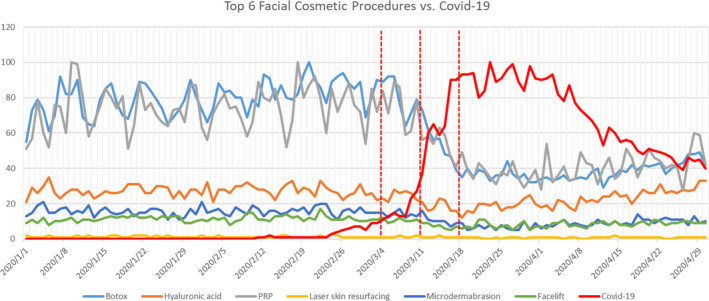
Top 6 Facial Cosmetic Procedures vs Covid‐19
3.2. Tweets per day
The number of daily tweets in the post‐declaration is higher than the pre‐declaration and might continue to rise in the future (Figure 2). It can be noticed that three peaks appeared on February 20, 2020, March 24, 2020, and April 27, 2020.
Figure 2.
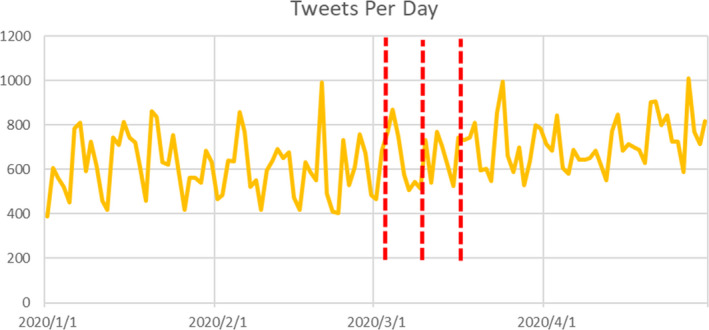
Tweets Per Day
As shown in Figure 3A, the number of tweets per day increased significantly during the post‐declaration period ([618.06 ± 138.32] vs [718.23 ± 115.87], t = −3.944, P < .001). In Figure 3B, because the data fluctuate greatly, the original data are processed logarithmically. As we can see, the tweets about “Botulinum Toxin Type A (Botox)” ([367.95 ± 102.30] vs [412.11 ± 96.22], t = −2.284, P < .05), “Hyaluronic Acid” ([48.97 ± 22.84] vs [76.61 ± 18.19], t = −6.697, P < .001) and “Facelift (Rhytidectomy)” ([116.78 ± 40.95] vs [145.50 ± 38.94], t = −3.653, P < .001) all significantly increased in the post‐declaration, the tweets about “PRP” significantly decreased ([56.31 ± 22.96] vs [48.576 ± 15.60], t = 2.087, P < .05), and there were no statistically significant differences in the number of tweets about “Laser Skin Resurfacing” and “Microdermabrasion.”
Figure 3.
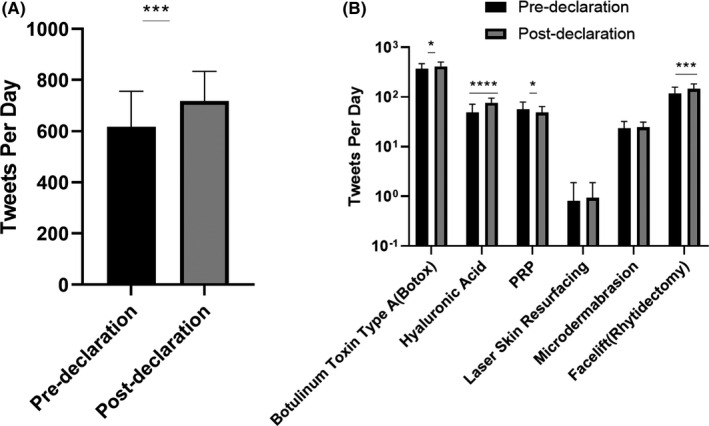
The number of changes of tweets between pre‐declaration and post‐declaration
We found significantly different rates distributions of the tweets in these five groups (Botulinum Toxin Type A (Botox), Hyaluronic Acid, PRP, Microdermabrasion, and Facelift (Rhytidectomy)) between the pre‐declaration and post‐declaration; χ2 = 303,621, P < .001 (Table 1). Rates about Hyaluronic Acid and Facelift (Rhytidectomy) tended to increase over the post‐declaration period, rates about Botulinum Toxin Type A (Botox), PRP, and Microdermabrasion decreased over the period, and rates about Laser Skin Resurfacing showed no significant differences.
Table 1.
The comparison of the number of tweets
| Pre‐declaration | Post‐declaration | χ 2 | P | |
|---|---|---|---|---|
| Botulinum Toxin Type A(Botox) a | 23 594 (59.9%) | 18 133 (58.2%) | 303.621 | <.001 |
| Hyaluronic Acid a | 3134 (8.0%) | 3371 (10.8%) | ||
| PRP a | 3604 (9.2%) | 2137 (6.9%) | ||
| Laser Skin Resurfacing | 52 | 41 | ||
| Microdermabrasion a | 1508 (3.8%) | 1078 (3.5%) | ||
| Facelift(Rhytidectomy) a | 7474 (19.0%) | 6402 (20.5%) |
Indicates that the ratio is significantly different on the 0.05 level.
3.3. Sentiment Analysis
In the post‐declaration, the sentiment score is lower than the pre‐declaration ([0.19 ± 0.44] vs [0.12 ± 0.44], t = 19.337, P < .001) (Figure 4A). The public showed more negative emotions after the declaration of COVID‐19. The sentiment score decreased in the tweets about Botulinum Toxin Type A (Botox) ([0.14 ± 0.45] vs. [0.04 ± 0.45], t = 20.851, P < .001), Hyaluronic Acid ([0.39 ± 0.40] vs. [0.35 ± 0.42], t = 3.735, P < .001), PRP ([0.25 ± 0.43] vs. [0.23 ± 0,43], t = 2.038, P < .05), Microdermabrasion ([0.34 ± 0.41] vs.(0.25 ± 0.40], t = 5.429, P < .001) and Facelift (Rhytidectomy) ([0.20 ± 0.38] vs.(0.16 ± 0.40], t = 5.767, P < .001) (Figure 4B). The distributions of the sentiments are significantly different from the pre‐declaration and post‐declaration (χ2 = 297.25, P < .001). Ratio about positive sentiment reduced and negative sentiment increased in the post‐declaration (Table 2). It can be seen more intuitively in Figure 4C.
Figure 4.
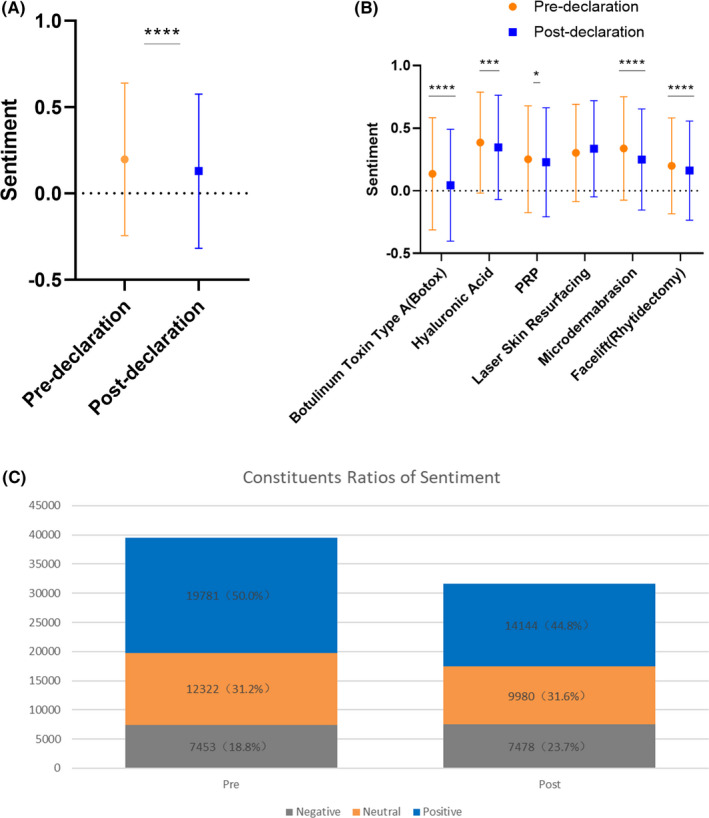
A, B The number of changes of tweets between pre‐declaration and post‐declaration. C: Constituents Ratios of Sentiment
Table 2.
The comparison of the sentiment analysis
| Negative | Neutral | Positive | χ 2 | P | |
|---|---|---|---|---|---|
| Pre | 7453 (18.8%) | 12 322 (31.2%) | 19 781 (50.0%) | 297.25 | <.001 |
| Post | 7478 (23.7%) | 9980 (31.6%) | 14 144 (44.8%) |
3.4. Frequency analysis and word cloud
The words “quarantine” and “lockdown” emerged in the post‐declaration, which were barely mentioned in the pre‐declaration. The words frequency of “speaker pelosi,” “wait,” and “god” increased. The words frequency of “happy,“ “beautiful,” “purchase,” “offer,” and “discounts” decreased (Figure 5).
Figure 5.
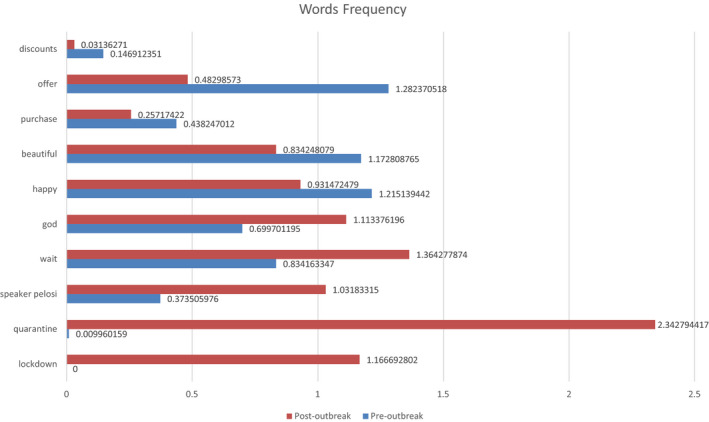
Words Frequency
Figure 6A shows the word cloud related to facial rejuvenation in the pre‐declaration, and Figure 6B shows it in the post‐declaration. The dominant words were “Botox,” “facelift,” “hyaluronic,” and “skin.” At the same time, words related to COVID‐19, such as “quarantine,” began to appear.
Figure 6.
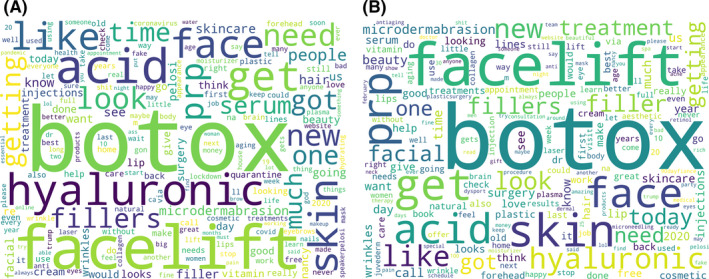
A, B The word cloud related to facial rejuvenation
4. DISCUSSION
The main objective of this study was to analyze a set of tweets associated with facial rejuvenation procedures during the COVID‐19 epidemic.
People searching terms in Google Trends indicate that they want to learn more about facial rejuvenation procedures to help them take action. Considering the presence of lockdown and the recession of economics, it is not surprising that search interest based on Google Trends has a low search volume in the post‐declaration. The volume of search terms such as “Botox,” “Hyaluronic acid,” “PRP” had been beginning to pick up recently in Google Trends. We were able to infer that some market requirements and people who work in this field could prepare in advance.
The results of Tweets Per Day show that the behavior of celebrities will increase people's attention to facial rejuvenation. This is consistent with the previous research. 17 For example, a significant peak occurred on February 20, 2020. On this day, Salma Hayek responded gracefully to an Instagram follower who said she had “Too Much Botox” on Twitter. On March 24, 2020 and April 27, 2020, these peaks were related to Nancy Pelosi. Some Twitter users have unfriendly comments about her.
The tweets of “Botulinum Toxin Type A (Botox),” “Hyaluronic Acid,” and “Facelift (Rhytidectomy)” all significantly increased in the post‐declaration period, which might mean that public had maintained a higher interest in this field. There's no contradiction between Google Trends and Twitter. People could not perform cosmetic surgery due to isolation, but this will not stop people from paying attention to facial rejuvenation. We found distributions of the tweets in the post‐declaration period rates about “Hyaluronic Acid” and “Facelift (Rhytidectomy)” increased slightly. The users of Twitter might more consider these two directions at this moment.
According to sentiment analysis, public sentiments related to facial rejuvenation tend to significantly negative in the post‐declaration because the general mood has been affected by the COVID‐19 epidemic. This point has been confirmed by previous research. 18 , 19 , 20 , 21 Despite this, a piece of good news is that a positive attitude always plays essential roles. We could infer that facial rejuvenation is still a field replete with confidence. Clinical practitioners could get into the business in positive moods.
The words about minimally invasive procedures are more prominent in the cloud, such as “Botox”, “Hyaluronic acid,” and “PRP”. Among the search terms related to facial rejuvenation, the attention of “Botox” is always the highest. “Look” and “face” were most mentioned when the public posted tweets about facial rejuvenation. By comparing with two pictures of word cloud, we can find that “hyaluronic acid” becomes more evident than “PRP.” This may provide practitioners insight into the public demand for facial rejuvenation. In the post‐declaration, the declining frequency of words “discounts,” “purchase” might mean that the COVID‐19 epidemic directly affects the consumer appetites to the public.
Given the preceding, it is shown that the public still maintains a high interest in facial rejuvenation, but the existence of the blockade hinders their face‐to‐face treatment. Recent studies have shown that during the COVID‐19 pandemic, teledermatology is regarded as an essential weapon in the hands of physicians and can be used as a time effective substitute of face‐to‐face visit for many skin complaints. 22 , 23 This suggests that clinicians interested in facial rejuvenation can consider using social media such as Twitter to provide high‐quality telemedicine services to the public.
There is one major limitation of our study. While this study is one of the first to analyze tweets related to facial rejuvenation and COVID‐19, it is limited by the users of Twitter who might use colloquial words to post tweets. Therefore, some relevant tweets may have been unintentionally missed.
In conclusion, the study analyzes the influence of the pandemic dissemination of COVID‐19 on facial rejuvenation. The public has a positive attitude toward facial rejuvenation. In particular, minimally invasive procedures dominate the mainstream, such as “Botox,” “Hyaluronic acid,” and “PRP.” The practitioners could understand the change of the public interest in facial rejuvenation in time and decide what to focus on.
CONFLICT OF INTEREST
The authors report no conflicts of interest.
AUTHOR CONTRIBUTIONS
LBL and GSL designed this study; RP analyzed and interpreted the data, and was major contributors in writing the manuscript. ZRW, WHL, ZC, XC, and HZ analyzed and interpreted the data. All authors read and approved the final manuscript.
Pang R, Wei Z, Liu W, et al. Influence of the pandemic dissemination of COVID‐19 on facial rejuvenation: A survey of Twitter. J Cosmet Dermatol. 2020;19:2778–2784. 10.1111/jocd.13688
Ran Pang and Zhiru Wei are Co‐First authors.
Funding information
This work was supported by the University key scientific research project of Henan Province (No.20A320033).
DATA AVAILABILITY STATEMENT
The data that support the findings of this study are available from the corresponding author upon reasonable request.
REFERENCES
- 1. Gorbalenya AE, Baker SC, Baric RS, et al. The species Severe acute respiratory syndrome‐related coronavirus: classifying 2019‐nCoV and naming it SARS‐CoV‐2. Nat Microbiol. 2020;5(5):536–544. [DOI] [PMC free article] [PubMed] [Google Scholar]
- 2. World Health Organization . Coronavirus Disease (COVID‐19)—events as they happen; 2020. [cited May 25, 2020]. Available at: https://www.who.int/emergencies/diseases/novel‐coronavirus‐2019/events‐as‐they‐happen
- 3. COVID‐19 Dashboard by the Center for Systems Science and Engineering (CSSE) at Johns Hopkins University (JHU) [cited June 8, 2020]. Available at: https://coronavirus.jhu.edu/map.html
- 4. WHO Director‐General’s opening remarks at the media briefing on COVID‐19 ‐ 16 March 2020 [cited May 25, 2020]. Available at: https://www.who.int/dg/speeches/detail/who‐director‐general‐s‐opening‐remarks‐at‐the‐media‐briefing‐on‐covid‐19‐‐‐16‐march‐2020
- 5. Kim BJ, Choi JH, Lee Y. Development of Facial Rejuvenation Procedures: Thirty Years of Clinical Experience with Face Lifts. Arch Plast Surg. 2015;42(5):521‐531. [DOI] [PMC free article] [PubMed] [Google Scholar]
- 6. Devgan L, Singh P, Durairaj K. Minimally Invasive Facial Cosmetic Procedures. Otolaryngol Clin North Am. 2019;52(3). [DOI] [PubMed] [Google Scholar]
- 7. Dayan SH, Bacos JT, Ho T‐V, et al. Topical skin therapies in subjects undergoing full facial rejuvenation. J Cosmet Dermatol. 2019;18(3):798‐805. [DOI] [PubMed] [Google Scholar]
- 8. Genina Elina A, Surkov Yury I. Rapid Ultrasound Optical Clearing of Human Light and Dark Skin. IEEE Trans Med Imaging. 2020;1. [DOI] [PubMed] [Google Scholar]
- 9. Twitter . Quarterly Results: 2020 First Quarter [cited May 25, 2020]. Available at: https://investor.twitterinc.com/financial‐information/quarterly‐results/default.aspx
- 10. Sewalk KC, Tuli G, Hswen Y, Brownstein JS, Hawkins JB. Using Twitter to Examine Web‐Based Patient Experience Sentiments in the United States: Longitudinal Study. J Med Internet Res. 2018;20(10):e10043. [DOI] [PMC free article] [PubMed] [Google Scholar]
- 11. Jacek R, Anthony S, Jacobsen Kathryn H, et al. The Measles Vaccination Narrative in Twitter: A Quantitative Analysis. JMIR Public Health Surveill. 2016;2:e1. [DOI] [PMC free article] [PubMed] [Google Scholar]
- 12. Xujuan Z, Enrico C, Guy T, et al. Using social connection information to improve opinion mining: Identifying negative sentiment about HPV vaccines on Twitter. Stud Health Technol Inform. 2015;216:761‐765. [PubMed] [Google Scholar]
- 13. Dredze M, Wood‐Doughty Z, Quinn SC, Broniatowski DA. Vaccine opponents' use of Twitter during the 2016 US presidential election: Implications for practice and policy. Vaccine. 2017;35(36):4670‐4672. [DOI] [PubMed] [Google Scholar]
- 14. Plastic Surgery Statistics Report. ASPS National Clearinghouse of Plastic Surgery Procedural Statistics [cited May 25, 2020]. Available at: . https://www.plasticsurgery.org/documents/News/Statistics/2018/plastic-surgery-statistics-full-report-2018.pdf
- 15. NetMarketShare Search Engine Market Share [cited May 25, 2020]. Available at: https://www.gs.statcounter.com/search-engine-market-share
- 16. Raghupathi V, Ren J, Raghupathi W. Studying Public Perception about Vaccination: A Sentiment Analysis of Tweets. Int J Environ Res Public Health. 2020;17(10):3464. [DOI] [PMC free article] [PubMed] [Google Scholar]
- 17. Thackeray R, Burton SH, Giraud‐Carrier C, Rollins S, Draper CR. Using Twitter for breast cancer prevention: an analysis of breast cancer awareness month. BMC Cancer. 2013;13(1):508. [DOI] [PMC free article] [PubMed] [Google Scholar]
- 18. Sijia LI, Yilin W, Jia X, et al. The Impact of COVID‐19 Epidemic Declaration on Psychological Consequences: A Study on Active Weibo Users. Int J Environ Res Public Health. 2020;17(6):2032. [DOI] [PMC free article] [PubMed] [Google Scholar]
- 19. John ATJ, Natalie JS, Michael AM. The behavioral immune system and social conservatism: A meta‐analysis. Evol Hum Behav. 2013;34:99‐108. [Google Scholar]
- 20. Mortensen CR, Becker DV, Ackerman JM, Neuberg SL, Kenrick DT. Infection breeds reticence: The effects of disease salience on self‐perceptions of personality and behavioral avoidance tendencies. Psychol. Sci. 2010;21:440‐447. [DOI] [PubMed] [Google Scholar]
- 21. Schaller M, Murray DR. Pathogens, personality, and culture: Disease prevalence predicts worldwide variability in sociosexuality, extraversion, and openness to experience. J Personal Soc Psychol. 2008;95:212‐221. [DOI] [PubMed] [Google Scholar]
- 22. Villani A, Annunziata MC, Abategiovanni L, Fabbrocini G. Teledermatology for acne patients: How to reduce face‐to‐face visits during COVID‐19 pandemic. J Cosmet Dermatol. 2020;19(8):1828. [DOI] [PMC free article] [PubMed] [Google Scholar]
- 23. Villani A, Scalvenzi M, Fabbrocini G. Teledermatology: a useful tool to fight COVID‐19. J Dermatolog Treat. 2020;31(4):325. [DOI] [PubMed] [Google Scholar]
Associated Data
This section collects any data citations, data availability statements, or supplementary materials included in this article.
Data Availability Statement
The data that support the findings of this study are available from the corresponding author upon reasonable request.


